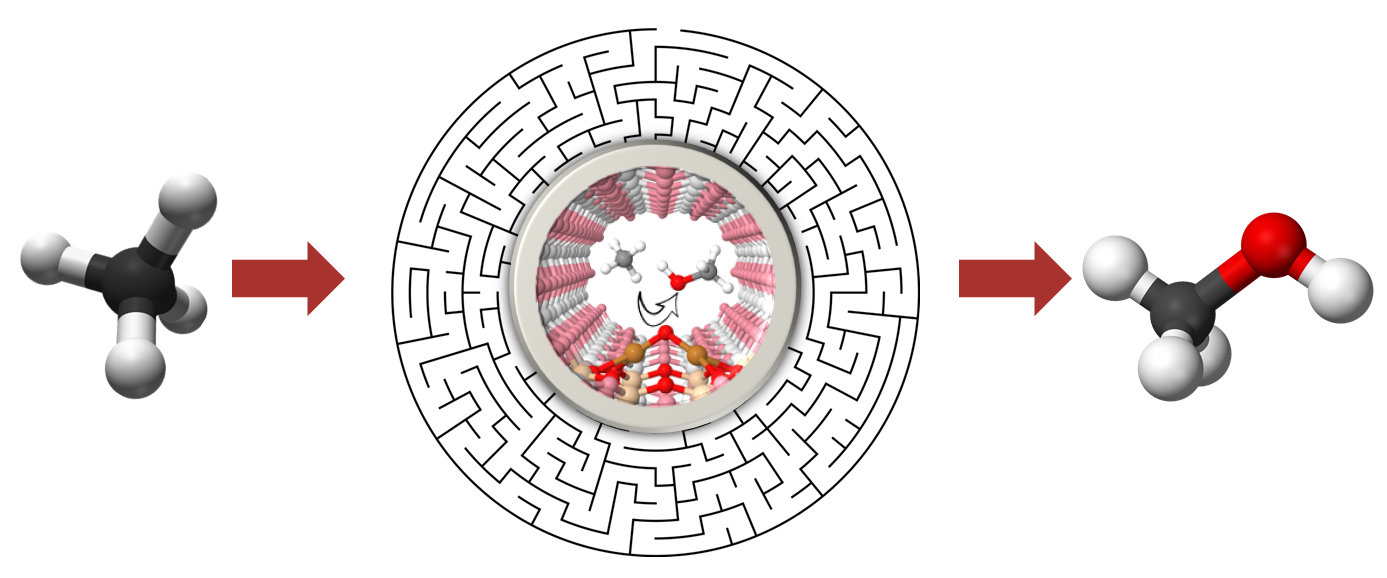Unravelling the chemical nature of anaerobic methane oxidation: the reaction profile maze
Conversion of methane to methanol is an industrially very important process, as it provides a sustainable route from an abundant and clean component of natural gas to one of the main precursors for chemicals synthesis. An efficient stepwise process catalysed by copper-exchanged zeolites has been suggested; however, a detailed understanding of the mechanism of such a zeolite-catalysed conversion is still missing. One of the ongoing debates in studying copper-exchanged zeolites is the exact configuration of the available catalytic sites. Another open question is the role of the nature of the oxidant, and the mechanism of methane oxidation and regeneration of the copper oxide active site.
We have recently shown [1] that a direct stepwise method for converting methane into methanol with high selectivity over a copper-containing zeolite can be achieved by partial oxidation with water, and proposed a mechanism involving methane oxidation at Cu(II) oxide active centers, followed by Cu(I) reoxidation by water with concurrent formation of hydrogen. However, the possibility of formation of various copper oxide species as active centers [2-4] opens a Pandora box of potentially feasible reaction pathways, including, but not limited to, the reactions over the mono- [5], di- [6], or tricopper [7] active species.
We use ab initio calculations to carefully study and analyze the possibility of alternative reaction pathways, and show that the unique behavior of copper mordenite zeolite relates to the reactivity of zeolite-supported copper oxide species, facilitating the two-electron redox process. We suggest a novel reaction pathway, and critically discuss the possibility of using various copper oxide species.

[1] V. L. Sushkevich, D. Palagin, M. Ranocchiari, J. A. van Bokhoven, Science, 2017, 356, 523-527.
[2] D. Palagin, A. J. Knorpp, A. B. Pinar, M. Ranocchiari, J. A. van Bokhoven, Nanoscale, 2017, 9, 1144-1153.
[3] P. Tomkins, A. Mansouri, S. E. Bozbag, F. Krumeich, M. B. Park, E. M. C. Alayon, M. Ranocchiari, J. A. van Bokhoven, Angew. Chem. Int. Ed., 2016, 55, 5467-5471.
[4] P. Tomkins, M. Ranocchiari, J. A. van Bokhoven, Acc. Chem. Res., 2017, 50, 418-425.
[5] A. R. Kulkarni, Z.-J. Zhao, S. Siahrostami, J. K. Nørskov, and F. Studt, ACS Catal., 2016, 6, 6531-6536.
[6] J. S. Woertink, P. J. Smeets, M. H. Groothaert, M. A. Vance, B. F. Sels, R. A. Schoonheydt, and E. I.
Solomon, Proc. Natl. Acad. Sci., 2009, 106, 18908-18913.
[7] S. Grundner, M. A.C. Markovits, G. Li, M. Tromp, E. A. Pidko, E. J. M. Hensen, A. Jentys, M. Sanchez-Sanchez, and J. A. Lercher, Nat. Comm., 2015, 6, 7546.